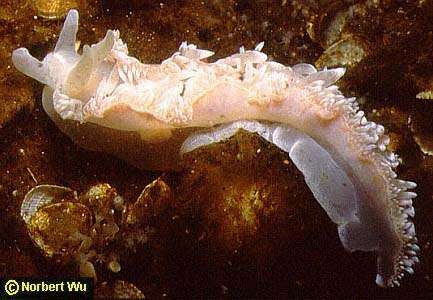
Notaeolidia schmekelae?
Wagele, 1990
Order: NUDIBRANCHIA
Suborder: AEOLIDINA
Family: Notaeolidiidae
DISTRIBUTION
Known only from the Weddell Sea, Antarctica, at depths between 249 and 481 metres.
PHOTO
McMurdo Sound, Antarctica. This photo is published with the permission of Norbert Wu from the Underwater Field Guide to Ross Island & McMurdo Sound, Antarctica .
According to Peter Brueggeman (in Underwater Field Guide to Ross Island & McMurdo Sound, Antarctica), Heike Wagele considers this photo to be of either Notaeolidia schmekelae or Notaeolidia gigas. At such a large size (about 10 centimeters long) she considers it to most probably be N. schmekelae but could only confirm that identification with a look at the reproductive system. N. schmekelae is the largest species, preserved animals of over 135mm being recorded. It had up to 4 rows of cerata around the mantle edge.See Notaeolidia depressa for a discussion about this Antarctic genus.
References:
• Barnes, D.K.A. & Bullough, L.W. (1996). Some observations on the diet and distribution of nudibranchs at Signy Island, Antarctica. Journal of Molluscan Studies 62, 281-287.
• Wagele, H. (1990). Revision of the antarctic genus Notaeolidia (Gastropoda, Nudibranchia), with a decription of a new species. Zoologica Scripta 19(3), 309-330.
• Wagele, H. (1991). The distribution of some endemic Antarctic nudibranchia. Journal of Molluscan Studies 57, 337-345.
• Wagele, H., Bullough, L.W., Barnes, D.K.A (1995). Anatomy of Pseudotritonia Thiele, 1912 and Notaeolidia Eliot, 1905 (Gastropoda: Opisthobranchia: Nudibranchia) from Signy Island, Antarctica. Journal of Molluscan Studies 61, 209-213.
Rudman, W.B., 1999 (February 10) Notaeolidia schmekelae? Wagele, 1990. [In] Sea Slug Forum. Australian Museum, Sydney. Available from http://www.seaslugforum.net/factsheet/notaschm
